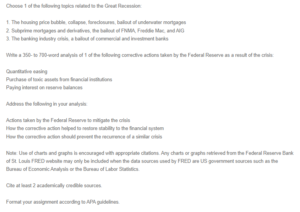The Great Recession – Purchase of Toxic Assets From Financial Institutions
In 2008, the American economy experienced intense turmoil due to a crisis in the financial system. The housing sector was particularly affected as the prices of houses reduced, foreclosures increased, the struggle to pay mortgages intensified, and delinquencies as well as strains in the mortgage market were witnessed. The crisis in the housing sector occurred following a rapid boom and sudden bust of house prices and constructions for residential purposes. As the prices of houses increased, the mortgage credit providers perceived their loans as sufficiently secured due to the increasing values of the collateral. Therefore, they paid less attention to the borrowers’ ability to make payments. The borrowers were categorized as underwater homeowners due to their high likelihood of defaulting on mortgages (Bernanke, 2008). The ability to service the high-cost mortgages is largely compromised by unemployment. The three main ways of default include foreclosures, short sale, and mortgage cures.
Due to the extent of the housing crisis, the Federal Reserve responded in various ways. One of the responses was purchasing toxic assets from financial institutions. The Federal Reserve sought to mitigate the effects of the crisis. Two years after the crisis, the Federal Reserve Bank of New York has been disclosing the purchase of toxic investments that it made while rescuing financial institutions such as the American International Group Inc. The Federal Reserve was heavily criticized for making these investments secretly. However, it argues that they were critical aspects of the housing crisis. The investments have been termed as a waste of taxpayers’ money. The Maiden Lane II and Maiden Lane III LLC were created to absorb these toxic assets. Maiden Lane II was disclosed as holding $34.5 billion, while Maiden Lane III supports at least $182 billion (Wagner, 2010).
The Federal Reserve responded and reiterated that secrecy while making these investments was called for. It was found necessary in rebuilding confidence within the financial sector as well as restabilize the banking sector. Revealing such information would have compromised the process of restoring confidence. Consequently, it would have been difficult to realize maximum value for the taxpayer in the long run.
These rescue efforts were ingrained in the Troubled Asset Relief Program (TARP), which was unveiled by Treasury Secretary Henry Paulson. TARP intended to utilize at least $700 billion of taxes in the USA for market stabilization. The proposition is to purchase troubled assets from large financial firms in the country to restore the lost confidence (Council on Foreign Relations, 2022). However, the plan was abandoned soon enough, an aspect that validates the critics’ concerns about the lack of transparency.
The TARP initiative had both positive and negative impacts. Its positive impact is the ability to absorb toxic assets that had a negative impact on the economy and stability of the financial sector. These assets could be disposed of after the crisis ends. The negative impact is the allocation of viable resources to purchase these toxic assets without the assurance of any substantial growth in value. These resources could have been put to better use. However, the indirect benefits of the action were related to rescuing institutions and the livelihoods that depended on them, thus avoiding the growth of unemployment (Van Aardt & Naidoo, 2010). There is no assurance that this response to prevent such a crisis in the future because it is reactive and not proactive.
References
Bernanke, B. S. (2008). Housing, Mortgage Markets, and Foreclosures. Retrieved from https://www.federalreserve.gov/newsevents/speech/bernanke20081204a.htm
Council on Foreign Relations. (2022). The U.S. Financial Crisis. Retrieved from Council on Foreign Relations: https://www.cfr.org/timeline/us-financial-crisis
Van Aardt, C. J., & Naidoo, G. P. (2010). The economic impact of the Troubled Assets Relief Programme (TARP) in the USA: an assessment of the level to which an optimal allocation of funds occurred. Southern African Business Review, 14(2), 46-64.
Wagner, D. (2010). Federal Reserve Discloses Toxic Assets It Bought to Rescue Banks, AIG. Insurance Journal.
ORDER A PLAGIARISM-FREE PAPER HERE
We’ll write everything from scratch
Question

Purchase of Toxic Assets From Financial Institutions
Choose 1 of the following topics related to the Great Recession:
1. The housing price bubble, collapse, foreclosures, bailout of underwater mortgages
2. Subprime mortgages and derivatives, the bailout of FNMA, Freddie Mac, and AIG
3. The banking industry crisis, a bailout of commercial and investment banks
Write a 350- to 700-word analysis of 1 of the following corrective actions taken by the Federal Reserve as a result of the crisis:
Quantitative easing
Purchase of toxic assets from financial institutions
Paying interest on reserve balances
Address the following in your analysis:
Actions taken by the Federal Reserve to mitigate the crisis
How the corrective action helped to restore stability to the financial system
How the corrective action should prevent the recurrence of a similar crisis
Note: Use of charts and graphs is encouraged with appropriate citations. Any charts or graphs retrieved from the Federal Reserve Bank of St. Louis FRED website may only be included when the data sources used by FRED are US government sources such as the Bureau of Economic Analysis or the Bureau of Labor Statistics.
Cite at least 2 academically credible sources.
Format your assignment according to APA guidelines.

